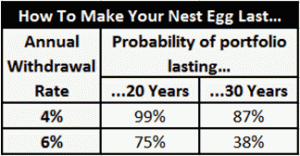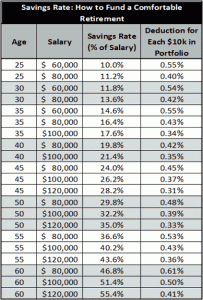Are You on Track for Retirement?
Sep 4, 2018 • Written by Paul Staib | Certified Financial Planner (CFP®), MBA, RICP®
Blog Home » Financial Planning » Are You on Track for Retirement?

As a financial planner, I receive questions on a daily basis regarding individual’s finances. While every question is different, ultimately a majority of the questions regarding retirement planning boil down to one of three fundamental questions:
- Am I on track for retirement?
- Am I doing the right things to put (or keep) myself on track to retire comfortably? and
- Do I have the right investments to get me there?
This posting focuses on the first question.
Are You on Track for Retirement?
The criteria and metrics utilized to answer this question are different depending upon whether you are already in retirement or whether you are saving for retirement.
For Retirees…
For retirees, one of the, if not THE, most critical and important metric for assessing the viability of your retirement plan is your Withdrawal Rate. The Withdrawal Rate is the percentage of your  aggregated withdrawals from your investment portfolio on an annual basis.
aggregated withdrawals from your investment portfolio on an annual basis.
Studies have determined that a 4% rate of withdrawal is a solid starting point for a sustainable withdrawal rate, assuming a 20-30 year retirement duration. As an example, if a retired couple had an aggregated investment portfolio of $600,000, using a 4% withdrawal target would result in an annual withdrawal target amount of $24,000.
As illustrated in the table to the right, the probability of retirement success is greatly diminished over time if the withdrawal rate exceeds 4%.
If you’re not yet retired, the critical question to answer is whether your current savings rate combined with your portfolio value to date puts you on track to reach your financial goals.
The table at right can give you a rough idea of the milestones that must be hit at various ages if you wish to retire with 80% of your pre-retirement income. It also assumes a retirement age of 65.
For example, a 45 year-old individual with gross income of $100,000 and who is just starting to save for retirement needs to save 26.2% of their salary. If they had already saved $300,000 for retirement, they would reduce their savings needs by 11.1% (0.37 * 30). Their annual savings rate target would then be 15.1%.
For a more personalized look at your progress, consider engaging a financial planner to determine a more detailed projection of how large a portfolio you need and your odds of reaching it.

Paul Staib | Certified Financial Planner (CFP®), MBA, RICP®
Paul Staib, Certified Financial Planner (CFP®), RICP®, is an independent Flat Fee-Only financial planner. Staib Financial Planning, LLC provides comprehensive financial planning, retirement planning, and investment management services to help clients in all financial situations achieve their personal financial goals. Staib Financial Planning, LLC serves clients as a fiduciary and never earns a commission of any kind. Our offices are located in the south Denver metro area, enabling us to conveniently serve clients in Highlands Ranch, Littleton, Lone Tree, Aurora, Parker, Denver Tech Center, Centennial, Castle Pines and surrounding communities. We also offer our services virtually.
Read Next
The Investor’s Guide to Income Taxes
• Written By Paul Staib | Certified Financial Planner (CFP®), MBA, RICP®
Key Points Understanding what constitutes income can help you pay less in taxes The amount of income you’re required to…
8 Behavioral Biases That May Hurt Your Investments
• Written By Paul Staib | Certified Financial Planner (CFP®), MBA, RICP®
Do you feel the pain of loss more than the joy of gains? How to separate emotions from investing. It’s…

